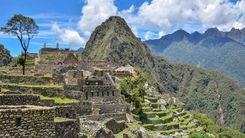Reserva Nacional Tambopata
Containing some of the world’s finest and most biodiverse rainforest, the RESERVA NACIONAL TAMBOPATA is one of the most easily accessible parts of relatively pristine Amazon rainforest and one of the best national parks in Peru. Described by National Geographic as one of the planet’s seven “iconic natural sanctuaries”, it is within easy reach of many of the lodges in the Puerto Maldonado region.
Transformed into a reserved zone mainly due to the scientific work of the adjacent Explorer’s Inn lodge, the area covers around 250,000 hectares, and is next to the Parque Nacional Bahuaja-Sonene, itself more than 1.5 million hectares. The expansion of the National Park is a major success for conservation in Peru, but despite this there are fears that the government has plans to open up the park in future to gas and oil exploitation.
It’s only possible to visit the National Park on a tour with a licensed operator. Tours organized from Cusco or Puerto Maldonado can enter en route to one of the major macaw salt licks (colpas) in the region. The licks are the best places to see wildlife in the jungle, since their salts, minerals and clay are highly nutritious, attracting large numbers of wild birds and animals.
Puerto Maldonado
A remote settlement even for Peru, PUERTO MALDONADO is a frontier colonist town with strong links to the Cusco region and a fervour for bubbly jungle chicha music. With an economy based on unsustainable lumber and gold extraction, and highly sustainable brazil-nut gathering from the rivers and forests of Madre de Dios, Puerto Maldonado has grown enormously over the last twenty years from a small, laidback outpost of civilization to a busy market town. Today, swollen by the arrival of businesses expecting a boom now that the road to Brazil is open, it’s the thriving, safe (and fairly expensive) capital of a region that feels very much on the threshold of major upheavals. Where, only thirty years ago, there were hardly any four-wheeled vehicles and the town’s only TV was set up outside the municipal building for the locals to watch football, these days enormous Brazilian trucks thunder past and satellite TV dishes have sprouted all over town.
While the busy city centre combines the usual bars and restaurants with pool halls, hammock shops and offices, there isn’t much in the way of specific attractions, and most visitors come here primarily to enter the forest and stay in a lodge.
Brief history
While gold mining and logging – both mostly illegal frontier businesses – keep Puerto Maldonado buzzing today, it was rubber that established the town at the beginning of the twentieth century. During the 1920s, game hunters dominated the economy of the region, and after them, mainly in the 1960s, the exploiters of mahogany and cedar trees arrived – leading to the construction of Boca Manu airstrip, just before the oil companies moved in during the 1970s. Most of the townspeople, riding coolly around on Honda motorbikes, are second-generation colonos, but there’s a constant stream of new and hopeful arrivals, both rich and poor, from all parts of South America. The lure, inevitably, is gold.
The saga of Fitzcarrald
While the infamous rubber baron, Fitzcarrald (often mistakenly called Fitzcarraldo), is associated with the founding of Puerto Maldonado, he actually died some twelve years before the event; his story is, however, relevant to the development of this region. While working rubber on the Río Urubamba, Fitzcarrald caught the gold bug after hearing rumours from local Ashaninka and Machiguenga Indians of an Inca fort protecting vast treasures, possibly around the Río Purus. Setting out along the Mishagua, a tributary of the Río Urubamba, he managed to reach its source, and from there walked over the ridge to a new watershed which he took to be the Purus, though it was in fact the Río Cashpajali, a tributary of the Río Manu. Leaving men to clear a path, he returned to Iquitos, and in 1884 came back to the region on a boat called La Contamana. He took the boat apart, and, with the aid of over a thousand Ashaninka and other Indians, carried it across to the “Purus”. But, as he cruised down, attacked by tribes at several points, Fitzcarrald slowly began to realize that the river was not the Purus – a fact confirmed when he eventually bumped into a Bolivian rubber collector.
Though he’d ended up on the wrong river, Fitzcarrald had discovered a link connecting the two great Amazonian watersheds. In Europe, the discovery was heralded as a great step forward in the exploration of South America, but for Peru it meant more rubber, a quicker route for its export and the beginning of the end for Madre de Dios’ indigenous tribes. Puerto Maldonado was founded in 1902, and as exploitation of the region’s rubber peaked, so too was there an increase in population of workers and merchants, with Madre de Dios ultimately becoming a departamento of Peru in 1912. German director Werner Herzog thought this historical episode a fitting subject for celluloid, and in 1982 directed the epic Fitzcarraldo.



